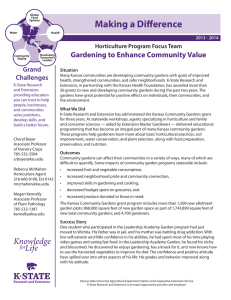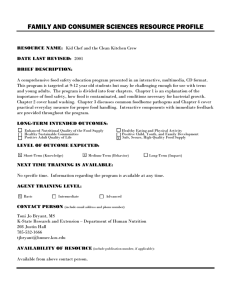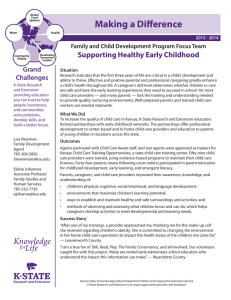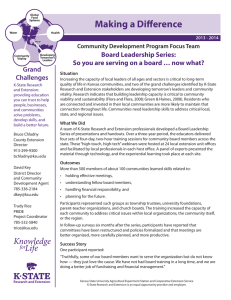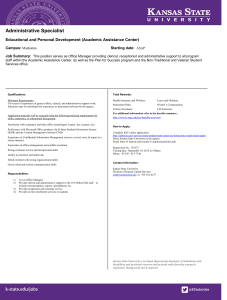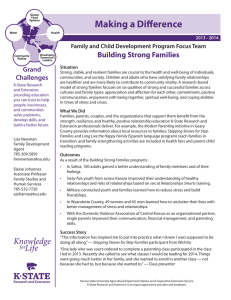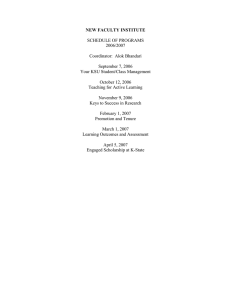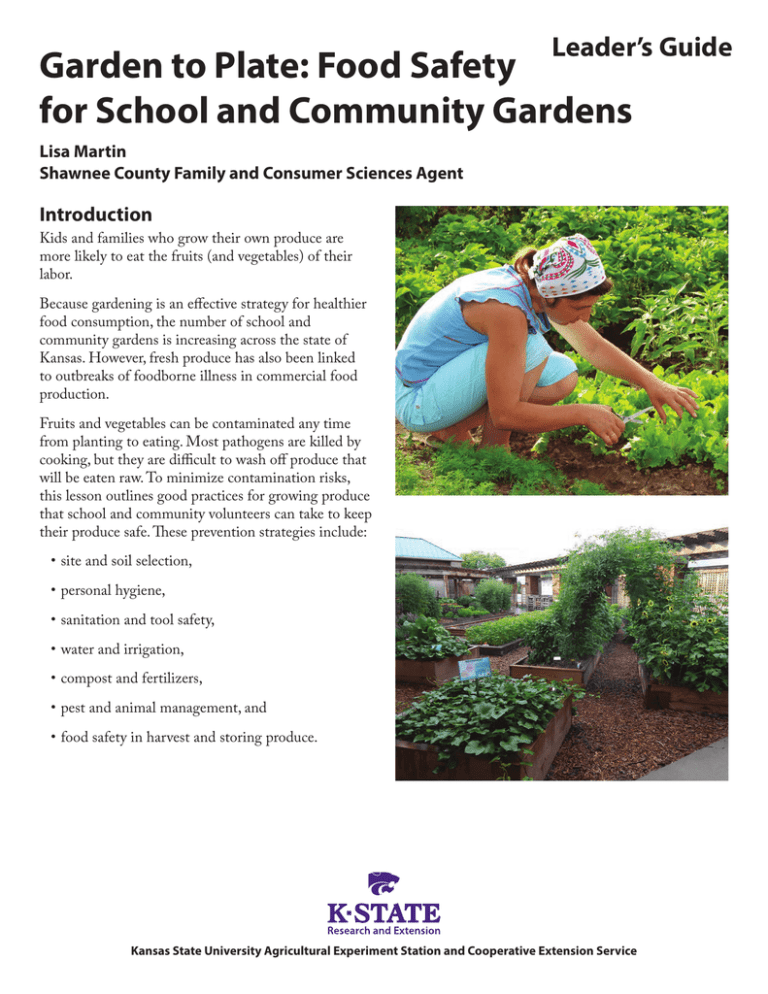
Leader’s Guide
Garden to Plate: Food Safety
for School and Community Gardens
Lisa Martin
Shawnee County Family and Consumer Sciences Agent
Introduction
Kids and families who grow their own produce are
more likely to eat the fruits (and vegetables) of their
labor.
Because gardening is an effective strategy for healthier
food consumption, the number of school and
community gardens is increasing across the state of
Kansas. However, fresh produce has also been linked
to outbreaks of foodborne illness in commercial food
production.
Fruits and vegetables can be contaminated any time
from planting to eating. Most pathogens are killed by
cooking, but they are difficult to wash off produce that
will be eaten raw. To minimize contamination risks,
this lesson outlines good practices for growing produce
that school and community volunteers can take to keep
their produce safe. These prevention strategies include:
•site and soil selection,
•personal hygiene,
•sanitation and tool safety,
•water and irrigation,
•compost and fertilizers,
•pest and animal management, and
•food safety in harvest and storing produce.
Kansas State University Agricultural Experiment Station and Cooperative Extension Service
Objectives
•Refrigerator thermometer
Participants will learn the importance of good practices
for keeping produce safe from garden to plate.
•Examples of suitable materials for composting/
sample of compost
•How to select and maintain safe soil.
•Compost thermometer — optional
•How to practice personal hygiene in regards to
gardening.
•Fruit and vegetable recipe samples — optional
•How to select and maintain safe water.
•How to practice food safety procedures.
Intended Audience
1.Provide pens or pencils.
2.Provide contact information
•Kansans
3.Have participants introduce themselves and tell
why they are attending.
•School and community volunteers
4.Review and discuss each section:
•Educators and teachers
Before the Lesson
1. Review this leader’s guide and the fact sheet
(MF3152), including the websites referenced.
2. Preview suggested videos in the fact sheet.
3. Visit with a horticulture agent. Consider team
teaching with a horticulture agent or Master
Gardener.
4. Visit a community/school garden site and
interview community/school garden volunteers.
5. Take pictures of local gardens to show various sites
and garden designs during programs.
Preparing for the Lesson
Before the lesson:
•Make copies of fact sheet and evaluations.
•Make copies of any optional supporting
information.
•Select websites and videos to show.
Lesson props:
•Basket of fresh fruits and vegetables
•Non-scented chlorine bleach
•Disposable gloves
•Food grade and nonfood grade containers
2
Presentation
•Vegetable brush
a.Site and Soil Selection
b.Personal Hygiene
c.Sanitation and Tool Safety
d.Water and Irrigation
e.Compost and Fertilizers
f. Pest and Animal Management
g.Food Safety in Harvesting and Storing Produce
5.Distribute evaluations.
6.Answer questions.
7.Thank audience for attendance and adjourn.
Resources
For more information, visit these online resources:
Websites:
Aquaponics: afsic.nal.usda.gov/aquaculture-and-soillessfarming/aquaponics
Food Safety Diseases: www.cdc.gov/foodsafety/diseases/
index.html
K-State Research and Extension Food Preservation:
www.rrc.ksu.edu/p.aspx?tabid=18
K-State Research and Extension Food Safety:
www.ksre.ksu.edu/foodsafety/
Kansas Community Gardens:
www.kansascommunitygardens.org/
K-State Research and Extension — From Garden to Plate: Food Safety for School and Community Gardens, Leader’s Guide
K-State Research and Extension—Lawn and Garden:
ksre.ksu.edu/p.aspx?tabid=24
Topeka Common Ground: topekagardens.com
Water Testing Information: www.kdheks.gov/envmicro/
testing_of_private_wells.htm
Videos:
Composting:
www.kansasgreenyards.org/p.aspx?tabid=37
How to Test Your Soil for Nutrients:
www.kansasgreenyards.org/p.aspx?tabid=37&itemID=36
Kansas Community Gardens, Video Series:
ksre.ksu.edu/p.aspx?tabid=24
•Why Start One?
•Choosing a Site
•Common Features
•Different Types
•Planning Ahead
•Preparing the Site
•Typical Costs
•Funding
•Getting Gardeners Involved
•Becoming a Community
Publications:
Cleaning and Sanitizing the Kitchen: Using Inexpensive
Household Food-Safe Products. University of Florida
Extension. edis.ifas.ufl.edu/pdffiles/FY/FY128000.pdf
Fertilizing Gardens in Kansas. K-State Research and
Extension. www.ksre.ksu.edu/bookstore/pubs/MF2320.
pdf
Food Facts, Raw Produce: Selecting and Serving it Safely.
U.S. Food and Drug Administration. www.fda.gov/
Food/ResourcesForYou/Consumers/ucm114299
Food Safety Tips for Your Edible Home Garden.
University of California, Davis.
ucfoodsafety.ucdavis.edu/files/26392.pdf
Food Safety for School and Community Gardens. North
Carolina State University and North Carolina
Cooperative Extension.
growingsafergardens.files.wordpress.com/2012/10/
foodsafetywebcurriculum-10-24-12.pdf
Food Safety Tips for School Gardens. USDA Food and
Nutrition Service. nfsmi.org/documentlibraryfiles/
PDF/20110822025700.pdf
Garden to Table: Five Steps to Food Safe Fruits and
Vegetables Home Gardening. University of New
Hampshire Cooperative Extension. extension.unh.edu/
resources/files/Resource001094_Rep1367.pdf
Grow It Eat It. University of Maryland Cooperative
Extension. chapmanfoodsafety.files.wordpress.
com/2011/08/foodsafety.pdf
Home Gardening Food Safety: Washing the Fruits (and
Vegetables) of Your Labor Properly. University of Florida
Extension. edis.ifas.ufl.edu/pdffiles/FY/FY140100.pdf
Kansas Garden Guide. K-State Research and Extension.
www.ksre.ksu.edu/bookstore/pubs/s51.pdf
Preventing E. coli: From Garden to Plate. Colorado
State University Extension. www.ext.colostate.edu/pubs/
foodnut/09369.html
Storing Fresh Fruits and Vegetables for Better Taste.
University of California, Davis. ucce.ucdavis.edu/files/
datastore/234-1920.pdf
Quick Composting. K-State Research and Extension.
www.ksre.ksu.edu/bookstore/pubs/EP6.pdf
Author
Lisa Martin, Shawnee County family and consumer
sciences agent
Reviewers
Cary Rivard, assistant professor of horticulture
Karen Blakeslee, extension associate and Rapid
Response Center coordinator
Londa Nwadike, extension food safety specialist
K-State Research and Extension — From Garden to Plate: Food Safety for School and Community Gardens, Leader’s Guide
3
Garden to Plate: Food Safety for School and Community Gardens Evaluation
Before
Presentation
Y N
Y N
Y N
Y N
Y N
Y N
Y N
Y N
Y N
Y N
After
Presentation
Y N
Y N
Y N
Y N
Y N
Y N
Y N
Y N
Y N
Y N
Knowledge of Food Safety for School and Community Gardens
1. I know why food safety is important.
2. I know how to handle food safely.
3. I know why washing my hands is important.
4. I know what causes foodborne illness.
5. I know how to prevent foodborne illness.
6. I know how to select safe garden sites and soil.
7. I know how to keep my garden area and tools safe and sanitized.
8. I know how to identify safe water sources for my garden.
9. I know how to keep a safe compost pile.
10. I think this lesson was useful and will help me prevent foodborne illness.
Comments and Suggestions: ___________________________________________________________________________
___________________________________________________________________________________________________
___________________________________________________________________________________________________
Please send completed evaluation to:
Lisa Martin, MPH, R.D., L.D.
Shawnee County Extension Agent, EFNEP
1740 SW Western
Topeka, KS 66604
785-232-0062, ext. 119
ljmartin@ksu.edu
Publications from Kansas State University are available at: www.ksre.ksu.edu
Publications are reviewed or revised annually by appropriate faculty to reflect
current research and practice. Date shown is that of publication or last revision.
Contents of this publication may be freely reproduced for educational purposes.
All other rights reserved. In each case, credit author, Garden to Plate: Food Safety
for School and Community Gardens, Leader’s Guide, Kansas State University, August
2014.
Kansas State University Agricultural Experiment Station and Cooperative
Extension Service
K-State Research and Extension is an equal opportunity provider and employer.
Issued in furtherance of Cooperative Extension Work, Acts of May 8 and June
30, 1914, as amended. Kansas State University, County Extension Councils,
Extension Districts, and United States Department of Agriculture Cooperating,
John D. Floros, Director.
MF3153
August 2014

